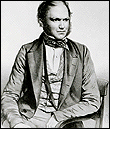Return to Online
Education Kit
|
 |
 |
Next Event 
1859: Darwin Published On the Origin of Species, Proposing Continual Evolution of Species
 The first printing of Charles Darwin's book, On the Origin of Species by Means of Natural Selection, or the Preservation of Favoured Races in the Struggle for Life, sold out in a matter of days. Darwin considered the volume a short abstract of the ideas he'd been developing about evolution by natural selection for decades. He'd been building on his ideas since his five-year journey in the 1830s to the South American coast, the Galapagos Islands, and other regions on the British ship H.M.S. Beagle. Darwin probably wouldn't have published in 1859 if not spurred by Alfred Russel Wallace's paper touching on the idea of natural selection. Wallace was a young naturalist who had developed his ideas while working in the islands of the Malay Archipelago. The first printing of Charles Darwin's book, On the Origin of Species by Means of Natural Selection, or the Preservation of Favoured Races in the Struggle for Life, sold out in a matter of days. Darwin considered the volume a short abstract of the ideas he'd been developing about evolution by natural selection for decades. He'd been building on his ideas since his five-year journey in the 1830s to the South American coast, the Galapagos Islands, and other regions on the British ship H.M.S. Beagle. Darwin probably wouldn't have published in 1859 if not spurred by Alfred Russel Wallace's paper touching on the idea of natural selection. Wallace was a young naturalist who had developed his ideas while working in the islands of the Malay Archipelago.
Darwin's exploratory survey on the H.M.S. Beagle had brought him into contact with a wide variety of living organisms and fossils. The adaptations he saw in the finches and tortoises on the Galapagos Islands struck him particularly acutely. Darwin concluded that species change through natural selection, or - to use Wallace's phrase - through "the survival of the fittest" in a given environment.
Darwin's book immediately attracted attention and controversy, not only from the scientific community, but also from the general public, who were ignited by the social and religious implications of the theory. Darwin eventually produced six editions of this book.
In time, a growing understanding of genetics and of the fact that genes inherited from both parents remain distinct entities - even if the characteristics of parents appear to blend in their children - explained how natural selection could work and helped vindicate Darwin's proposal.
Charles Darwin's On the Origin of Species by Means of Natural Selection, or the Preservation of Favoured Races in the Struggle for Life remains in print, in many languages.
Next Event 
Last Updated: July 7, 2008
|

